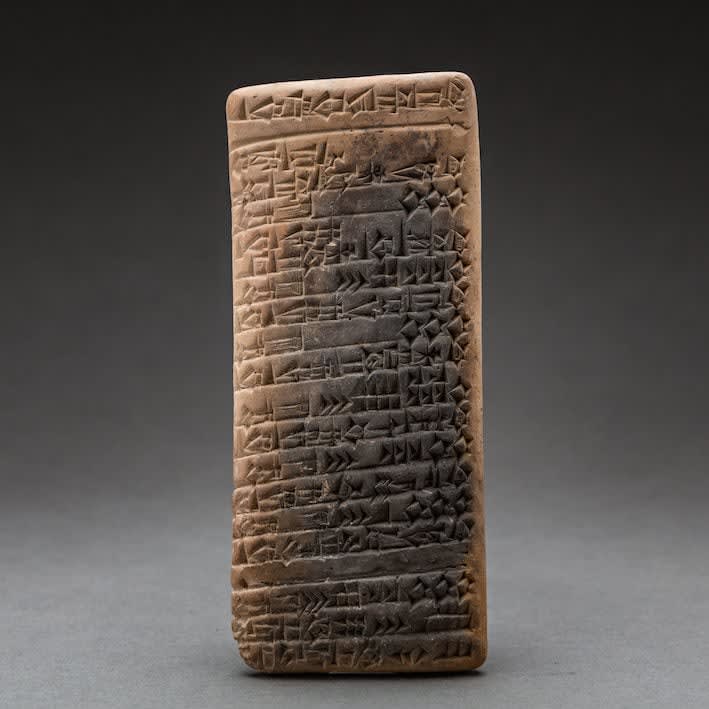Sumerian Cuneiform Tablet, 2038 BCE
Terracotta
2.5 x 5.75
LSO.302
Sumerian cuneiform is one of the earliest known forms of written expression. First appearing in the 4th millennium BC in what is now Iraq, it was dubbed cuneiform (‘wedge-shaped’) because...
Sumerian cuneiform is one of the earliest known forms of written expression. First appearing in the 4th millennium BC in what is now Iraq, it was dubbed cuneiform (‘wedge-shaped’) because of the distinctive wedge form of the letters, created by pressing a reed stylus into wet clay. Early Sumerian writings were essentially pictograms, which became simplified in the early and mid 3rd millennium BC to a series of strokes, along with a commensurate reduction in the number of discrete signs used (from c.1500 to 600). The script system had a very long life, and was used by the Sumerians as well as numerous later groups – notably the Assyrians, Elamites, Akkadians and Hittites – for around three thousand years. Certain signs and phonetic standards live on in modern languages of the Middle and Far East, but the writing system is essentially extinct. It was therefore cause for great excitement when the ‘code’ of ancient cuneiform was cracked by a group of English, French and German Assyriologists and philologists in the mid 19th century AD. This opened up a vital source of information about these ancient groups that could not have been obtained in any other way. Cuneiform was used on monuments dedicated to heroic – and usually royal – individuals, but perhaps it’s most important function was that of record keeping. The palace-based society at Ur and other large urban centres was accompanied by a remarkably complex and multifaceted bureaucracy, which was run by professional administrators and a priestly class, all of whom were answerable to central court control. Most of what we know about the way the culture was run and administered comes from cuneiform tablets, which record the everyday running of the temple and palace complexes in minute detail, as in the present case. The Barakat Gallery has secured the services of Professor Lambert (University of Birmingham), a renowned expert in decipherment and translation of cuneiform, to examine and process the information on these tablets. His analysis is presented below. Clay tablet, 144 x 62 mm, with 34 Lines of Sumerian Cuneiform on Obverse and Revers This is excellently preserved, save for a slight chip on the upper right hand corner. There is some hard incrustation on the reverse which obscures some of the writing, but it could be removed with laboratory treatment. The text is an administrative doeument from the period of the Third Dynasty of Ur, dated to the 9th year of Amar-Sin, third king of the dynasty, c. 2038 BC. It is an account of cornel rods and reeds gathered up for various uses by the temple workers of the same temple estate. It is written in a large, clear scribal hand: 192 talents of…rod 576 talents of rod 12330 bundles of reeds, from the guard of the reed bundle 10890 bundles of reeds, from Azina, manage 9030 bundles of reeds, from Arshi-a 7110 bundles of reeds, from Ilum-rabi, manage 10800 bundles of reeds, from Mashum, manage 5670 bundles of reeds from Puzur-Lisi, manage 10800 bundles of reeds from Lu-Nanna, store manager of Nadatum from the central stock Total………
Total………
Total………: total stocks, from them: 192 talents………
576………
66630 bundles of reeds: for next yea Lu-dingirra, manager, received, document of Baba-t Disbursemen Account of Adallal, scribe, continuing disbursemen Year: the high priestess of Nanna of Karzida was installe *** In the lack of any native trees in Sumer, the hard cornel rods were highly esteemed andb used for various purposes. Reeds grew to over twenty feet high and served all kinds of purposes: making houses, boats, mats and reinforcement of the massive brick ziggurats.
Total………
Total………: total stocks, from them: 192 talents………
576………
66630 bundles of reeds: for next yea Lu-dingirra, manager, received, document of Baba-t Disbursemen Account of Adallal, scribe, continuing disbursemen Year: the high priestess of Nanna of Karzida was installe *** In the lack of any native trees in Sumer, the hard cornel rods were highly esteemed andb used for various purposes. Reeds grew to over twenty feet high and served all kinds of purposes: making houses, boats, mats and reinforcement of the massive brick ziggurats.



